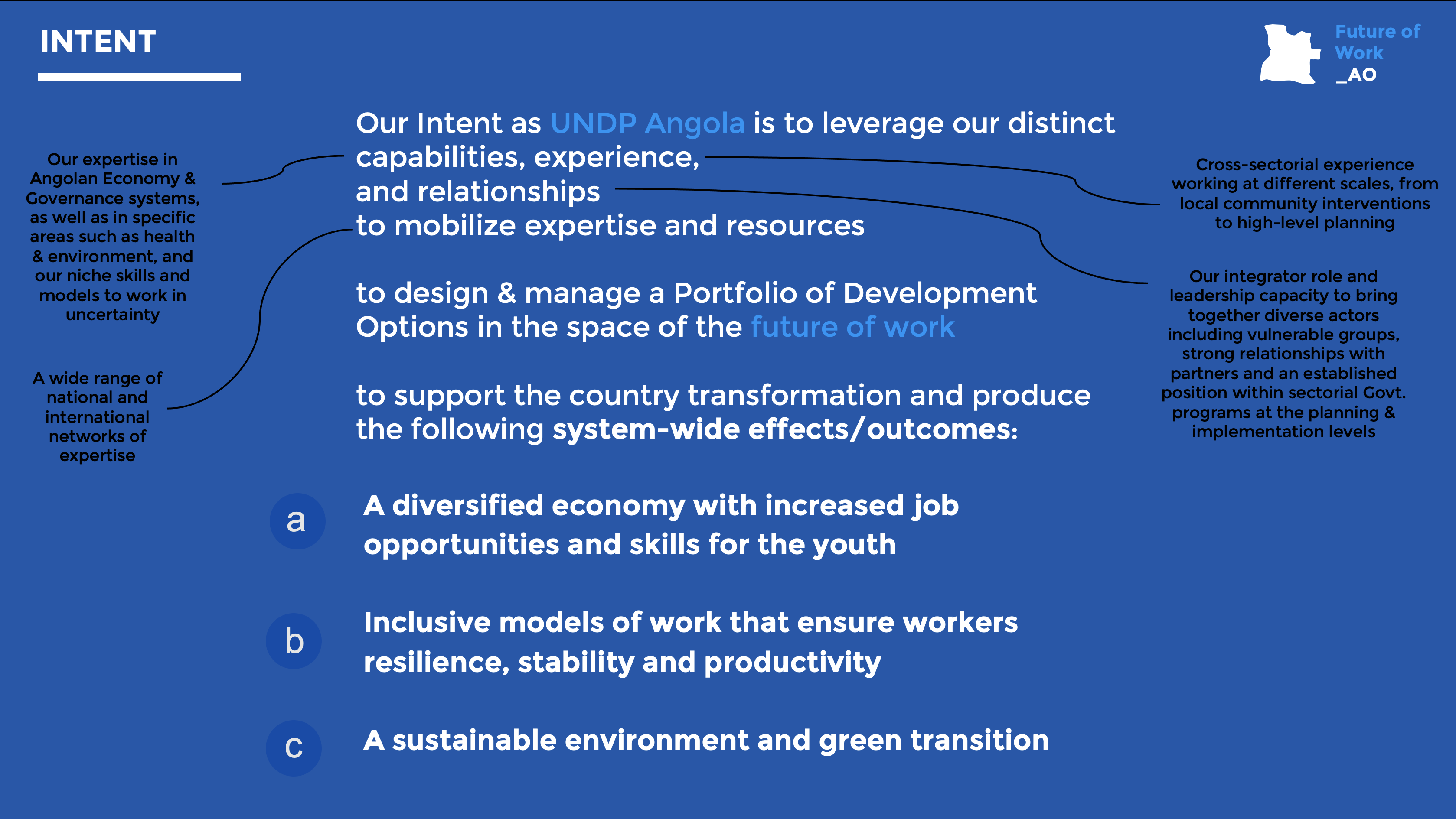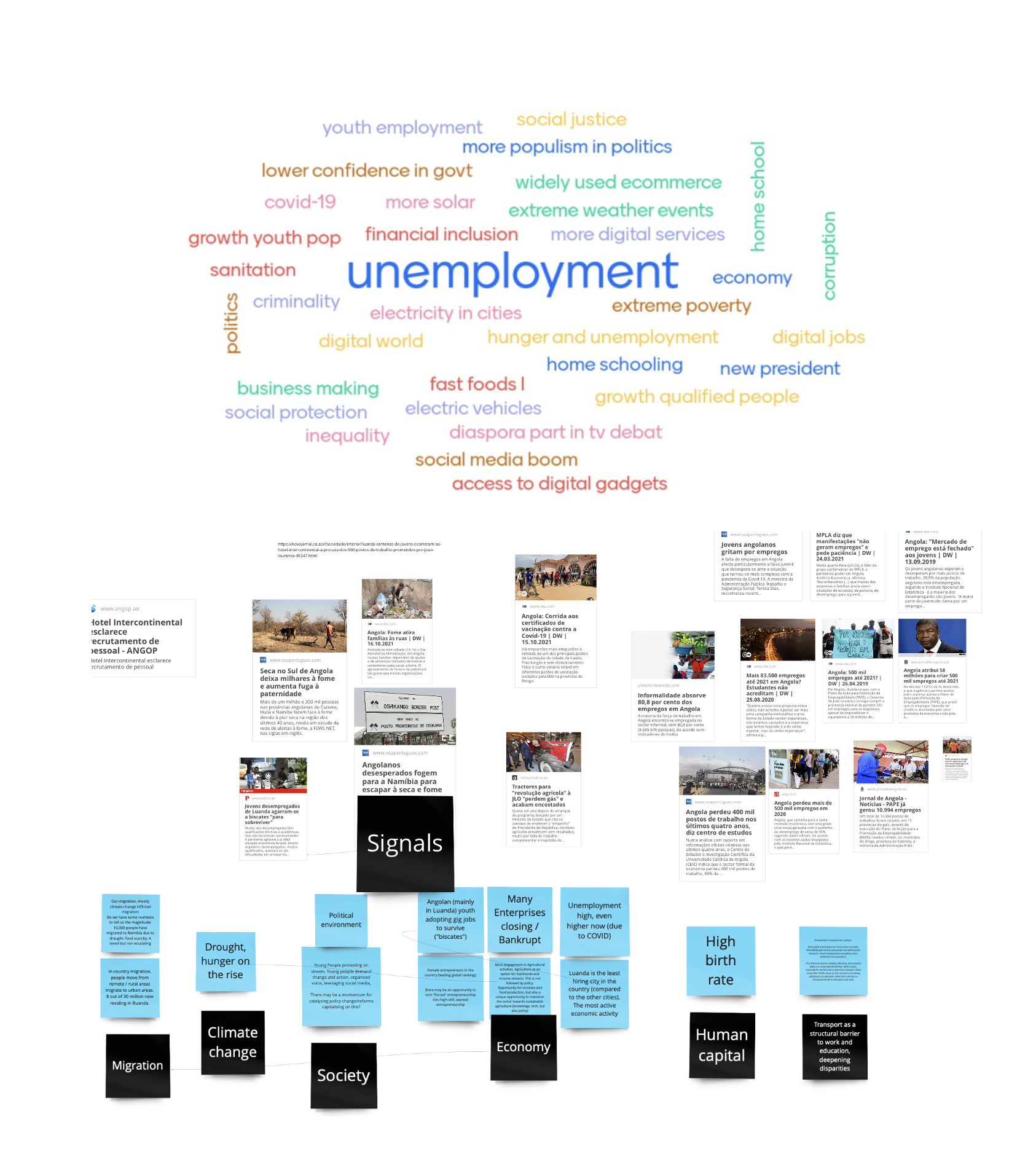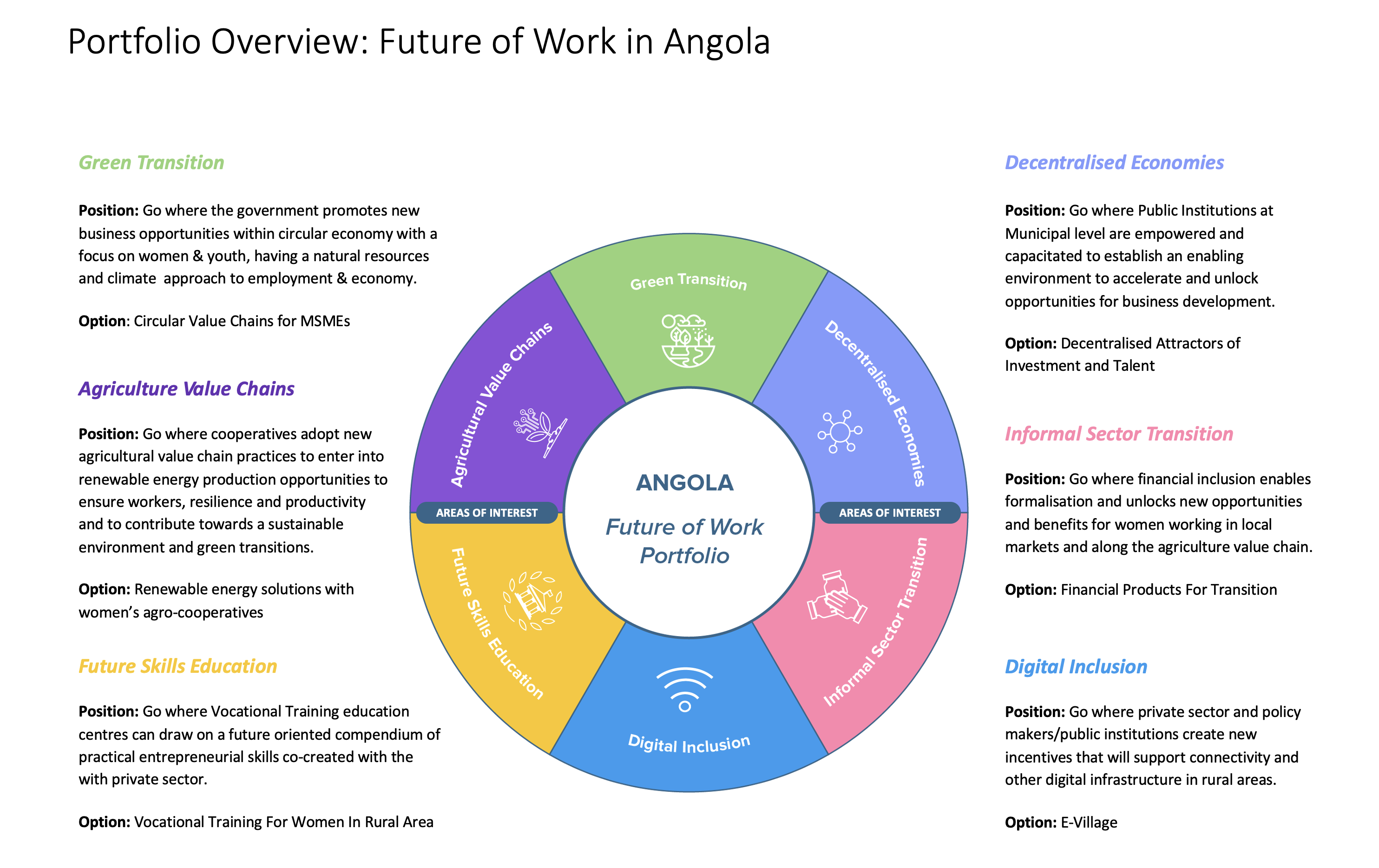By Judite Toloko da Silva (Head of Exploration) & Daniela Tavares de Lima (Head of Experimentation)
Envisioning the Future of Work in Angola (PART 2)
19 de Dezembro de 2022
As we said in the beginning, we want to build the future now, so we took all the learnings from the past, the present and trends for the future and established our intent. We know that the development we want to see emerging will rely in a systemic approach that will require action not only from us, but from many other actors in the system. But we wanted to create our ‘north star’ while remaining conscious of our capacity, agency, and its limitations and invite others to join us on this journey.

“Since you mentioned the future, what is it telling us?”
Earlier this year, United Nations Development Programme (UNDP) in Angola with the support of UNDP Strategic Innovation Unit (SIU), did two important internal workshops that kicked off this journey towards Future of Work in Angola.
Stop 1: Portfolio Sensemaking. It helped our office to look at the existing portfolio, identifying patterns, synergies, potential elements that could be strengthened.
Stop 2: Horizon Scanning. This allowed our team to generate insights on current trends and future changes in the work landscape, which were translated into strategical elements to consider when shaping the new portfolio.
“Horizon Scanning… Hum… Tell us more…”
We took the opportunity to do a scanning of potential factors that could impact work in Angola. We sensed, explored, and generated insights on current trends and future changes in the work landscape while keeping in the back of our minds the following questions:
- What are the current signals of change and threads that are emerging around work (local and global scale)?
- How can these signals be used for a more evidence-based and trend aligned portfolio of interventions?

“Alright, so what did you find out that you can share with us right now?”
When looking at trends and patterns emerging within the society it is impossible not to start by talking about the high birth rate which continues to increase, which positively affects human capital; yet as the population grows - and with the escalating economic and social crises, more young people are left with no or little opportunities. The education system, at all levels is not adapted to the demand both in quantity and quality. Out-migration, mostly climate-change inflicted migration. E.g. 10,000 people have migrated to Namibia due to draught and food scarcity. This is a trend, but not escalating. In-country migration: people move from remote / rural areas to urban areas. E.g. 8 out of 30 million now residing in Luanda which puts enormous pressure on housing, public services, infrastructure, quality of life. To some extent, all these factors end-up contributing to another potential trend specially in urban centers, the escalating unrest with young people at the forefront. Young people protesting on the streets and demanding change and concrete actions. Stronger and more organized voice of people (particularly young people who leverage social media). Covid-19 came as a last drop on the already existing food insecurity. This is mostly felt in the southern areas of the country which are also the major areas affected by drought. Environmental impact trends are heavily felt, and the increased drought due to climate change, is deepening poverty and triggering migration from affected areas. Signals of growing attention in green transition are visible, less concrete policy/informal action and not a systemic vision yet, but there are efforts to green trade and introduce green economic models.
From an economic standpoint, the country is witnessing a ‘massive’ return of families into subsistence agriculture. There is more engagement in small-scale subsistence agriculture, which provides opportunities for livelihoods, income streams and food security. This is followed by the Diversification of the Economy agenda but still could be followed by policy. This represents a unique opportunity for government to transition the sector towards sustainable agriculture (knowledge, tech, but also policy), which may connect to future green jobs. Due to the COVID-19 crisis, unemployment is higher than ever, a growing number of companies went bankrupt and there is a rise of the informal economy. Angolan youth (mainly in Luanda and other main urban centers) is adopting gig jobs to survive ("biscates"). We are also witnessing the rising of female entrepreneurs in the country, including in tech related businesses (leading global ranking), yet it is driven mainly by necessity and not followed by policies. There are isolated emerging practices that trigger 4IR and innovation, mostly driven by the private sector, tapping into innovation and technology for economic growth. Affordability and accessibility to public transportation remains difficult, hence, private transportation prevailing within/between settlements. Economic mobility consequently is affected with the high costs for service, reliability, predictability, and safety concerns specially for women due to late-hour transportation from work to home.
Some of the findings reinforced some of the assumptions that were already on the table, such as the urgent need for the creation of more jobs & opportunities for youth, diversification in work aligned with the diversification of the economy and the environment and Inclusive labour market that tackles inequalities and gender social norms. Not only that, reform in the education system where skills development, vocational training and capacity building meets market demands is crucial to avoid the mismatch between offer and demand as well as the great funneling of same skills being spilled in the job market.
“How about the Portfolio?”
In March 2022, the UNDP Angola Country Office Team commenced an 8-month Deep Demonstration (DD) journey. Supported by Chôra Foundation and the UNDP Strategic Innovation Unit (SIU), the Deep Demonstrations program applies Chôra Foundation’s System Transformation Framework to establish new Portfolio capabilities in support of System Transformation across the UNDP.
We have gathered insights and trends and designed our so-called Future of Work in Angola Portfolio. The Portfolio provides a deliberate spread of strategic Positions across the Future of Work Problem Space. These six Positions and the corresponding Development Options relate to and complement each other thus adding and layering to a Portfolio logic and effectiveness.
The Portfolio has a crosscutting gender lens, a distinctive ‘feminist approach’ that places a specific focus on women in all the positions. It is also deeply anchored to the agro-industrial sector as a predetermined effort to directly contribute to the diversification of the economy and informal transition. The interconnection between the areas of interest allows to develop positions and options that ‘sit somewhere in the middle, or everywhere at the same time’, they interconnect different areas of interest, which will contribute towards articulated results and increased impact.

The Portfolio will be implemented in a collaborative and successive way. While it will attract and sustain new deep collaborations with a variety of partners and stakeholders it will foster systemic learning, sensemaking and the discovery of new policy options and solutions to stimulate development for the Future of Work in Angola.
We mapped our existing country office projects as well as pipeline projects against our problem space and portfolio and we will keep building on it as we go. Portfolio approach is all about dynamic management and learning. Regularly reflecting on what we are doing and how it fits within the portfolio framework, how can we expand and push the boundaries to increase impact through a set of interconnected actions.
Here we say ‘we’, but we are also referring to partners and stakeholders that share with us the same intent, everyone who is working within the system and wants to bring about transformative change. The more we collaborate, working in a coordinated way, building on each other’s work, knowledge, capacity, and resources, the more we can increase our impact on the ground. So, dear future partners, if you’re somewhere out there reading this and feel like this somehow resonates with you, let’s work together!
This is a two-part blog post. Please click here to read part 1.

 Locations
Locations